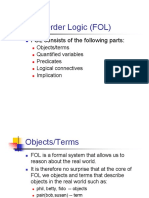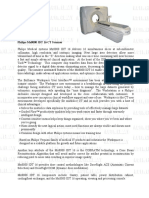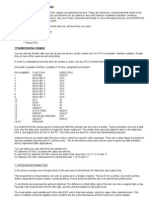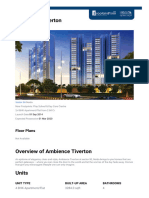Prolog Programming Exercises1
Uploaded by
atmroo9Prolog Programming Exercises1
Uploaded by
atmroo9Prolog programming exercises
Exercise 1 Starting with the "genealogy" code, define new predicates for "descendant", "sibling" and "uncle_or_aunt". Add some more "parent" facts to the collection (perhaps from your own relatives) and test out the predicates you introduced. Exercise 2 Does the following definition of ancestor allow queries which fail to terminate? (Note that the order of the two clauses has been reversed from the original definition). You can of course experiment with prolog to get an answer, but try to understand why, independently of experiment.
ancestor(X,Y):-parent(X,Z),ancestor(Z,Y). ancestor(X,Y):-parent(X,Y).
(Note: this is a "trick question") Exercise 3 Define a predicate subsequence(L1,L2) which is satisfied by any pair of lists L1 and L2 which have the property that the elements of L1 occur in order in L2, but are not necessarily consecutive. For example subsequence([tues,wed,sat], [mon,tues,wed,thurs,fri,sat,sun]) should be true, but subsequence([thurs,wed],[mon,tues,wed,thurs,fri,sat,sun]) should fail. Exercise 4 Define a predicate intersects(L1,L2) which is satisfied by lists L1 and L2 provided that they have an element in common. Exercise 5 Define a predicate bfora(L1,L2) which is satisfied by lists L1 and L2 provided that L2 is obtained from L1 by replacing all occurrences of a in L1 by b, including occurrences in sub-lists, sub-sub-lists and so on. (It might be useful to use the built-in predicate atom, which is satisfied by an argument consisting of an atom, but not by a more complicated term such as a list.)
Solutions to prolog exercises
Sample solutions to first set of cs205 logic programming exercises Solution 1
descendant(X,Y):-ancestor(Y,X). sibling(X,Y):-parent(Z,X), parent(Z,Y), X\==Y. % uncle_or_aunt(X,Y) will be defined % to mean that X is the uncle or aunt of Y uncle_or_aunt(X,Y):-parent(Z,Y),sibling(Z,X).
Solution 2 A query may fail to terminate if some parent relationships are given which are cyclic (hence could not arise in reality). For example
parent(bob,ann). parent(ann,gaz). parent(gaz,bob). parent(hal,betty).
The query ancestor(bob,hal) causes an infinite loop. (It's a trick question because the original definition of "ancestor" also fails in this situation. So in a sense this reversal of the clauses does not make the definition any worse.) Under "normal circumstances" queries will terminate. To see this, you have to appreciate how prolog ever gets to apply the second clause in the definition of ancestor. (Since the first is recursive, only the second can allow computation to end.) What happens is that given the query such as
ancestor(bob,X).
prolog will in fact find all the descendants of bob using the first clause, without ever using the second to verify that they are all bob's descendants. Eventually the first clause will start to fail - when bob's youngest descendants are reached they fail the first subgoal of being parents. At that point, prolog can start backtracking, giving up on the use of the first clause and trying out the second, and it will eventually do so for all descendants of bob. Solution 3
subsequence([],L). % the empty list is a subsequence of anything subsequence([Head|Tail],[Head|Tail2]) :- subsequence(Tail,Tail2). % if the two lists have the same leading element % then the first is a subsequence of the second % provided that the first without its leading element % is a subsequence of the second without that leading % element subsequence(L1,[Head|Tail]) :- subsequence(L1,Tail). % L1 is a subsequence of L2 if it is a subsequence % of L2 minus its leading element
Solution 4 It is easy to do this by defining an auxiliary predicate intersect2 which is satisfied by two lists if the head of the first list belongs to the second.
intersect2([Head|Tail1],[Head|Tail2]). intersect2([Head|Tail1],[Head2|Tail2]) :intersect2([Head|Tail1],Tail2). intersects([Head|Tail],L) :- intersect2([Head|Tail],L). intersects([Head|Tail],L) :- intersect2(Tail,L).
Solution 5
bfora([],[]). bfora(a,b). bfora(X,X) :- atom(X). bfora([H1|T1],[H2|T2]) :- bfora(H1,H2), bfora(T1,T2).
The predicate also replaces the atom a by b (as well as just working on the contents of lists). The second and third clauses deal with atoms in particular, replacing a with b, or failing that replacing an arbitrary atom by itself. Note that if you reject the answer to a query such as
bfora([[q,a,w],[a,q,a],q,a,e],L).
which initially gives
L = [[q,b,w],[b,q,b],q,b,e] ? then you get offered alternatives in which the last a may not have been replaced by b. This is due to using the third clause instead of the second (where the first argument is a, so that the second should have been used.)
You might also like
- Lec. 17 18 Manual Part Programming, Formats. Code and Cycles - SINUMERIK System 810 T100% (1)Lec. 17 18 Manual Part Programming, Formats. Code and Cycles - SINUMERIK System 810 T23 pages
- Empower Your Heart With Breakthrough Nitric Oxide Therapy - Tammy Hester100% (3)Empower Your Heart With Breakthrough Nitric Oxide Therapy - Tammy Hester20 pages
- Tutorial SHEET-3 Recursion: 1. Recursive DefinitionNo ratings yetTutorial SHEET-3 Recursion: 1. Recursive Definition10 pages
- L333 Introduction To Prolog - Answers To Exercises and DiscussionNo ratings yetL333 Introduction To Prolog - Answers To Exercises and Discussion10 pages
- Assignment # 1: Program 1: (Family-Hierarchy Problem)No ratings yetAssignment # 1: Program 1: (Family-Hierarchy Problem)11 pages
- TD1 - Mise À Niveau PROLOG: Exercice 1: Arbre GénéalogiqueNo ratings yetTD1 - Mise À Niveau PROLOG: Exercice 1: Arbre Généalogique5 pages
- Logic Programming and Prolog: A First GlimpseNo ratings yetLogic Programming and Prolog: A First Glimpse69 pages
- Pumac 2009-10 Power Test: 1 Instructions / RulesNo ratings yetPumac 2009-10 Power Test: 1 Instructions / Rules5 pages
- Unit 5 - Discrete Structures - WWW - Rgpvnotes.inNo ratings yetUnit 5 - Discrete Structures - WWW - Rgpvnotes.in15 pages
- Solutions To The 69th William Lowell Putnam Mathematical Competition Saturday, December 6, 2008No ratings yetSolutions To The 69th William Lowell Putnam Mathematical Competition Saturday, December 6, 20087 pages
- Logic Programming Tutorial 1: Prolog Warm-UpNo ratings yetLogic Programming Tutorial 1: Prolog Warm-Up2 pages
- Functions Sequences, Sums, Countability: Zeph GrunschlagNo ratings yetFunctions Sequences, Sums, Countability: Zeph Grunschlag61 pages
- LNAI 2842 Transductive Confidence Machine Is Universal 1st Edition by Ilia Nouretdinov, Vladimir Vyugin, Alex Gammerman ISBN 9783540200574 354020057X - Download the ebook and start exploring right away100% (4)LNAI 2842 Transductive Confidence Machine Is Universal 1st Edition by Ilia Nouretdinov, Vladimir Vyugin, Alex Gammerman ISBN 9783540200574 354020057X - Download the ebook and start exploring right away50 pages
- Prolog: Logic in Computer Science Lab SectionNo ratings yetProlog: Logic in Computer Science Lab Section45 pages
- Prolog: Logic in Computer Science Lab SectionNo ratings yetProlog: Logic in Computer Science Lab Section45 pages
- LNAI 2842 Transductive Confidence Machine Is Universal 1st Edition by Ilia Nouretdinov, Vladimir Vyugin, Alex Gammerman ISBN 9783540200574 354020057XdownloadNo ratings yetLNAI 2842 Transductive Confidence Machine Is Universal 1st Edition by Ilia Nouretdinov, Vladimir Vyugin, Alex Gammerman ISBN 9783540200574 354020057Xdownload35 pages
- MMW Mathematical Language Sets Logic Part2No ratings yetMMW Mathematical Language Sets Logic Part239 pages
- PrincipalComponentAnalysisofBinaryData - Applicationstoroll Call AnalysisNo ratings yetPrincipalComponentAnalysisofBinaryData - Applicationstoroll Call Analysis32 pages
- LNAI 2842 Transductive Confidence Machine Is Universal 1st Edition by Ilia Nouretdinov, Vladimir Vyugin, Alex Gammerman ISBN 9783540200574 354020057X - Read the ebook online or download it for a complete experience100% (7)LNAI 2842 Transductive Confidence Machine Is Universal 1st Edition by Ilia Nouretdinov, Vladimir Vyugin, Alex Gammerman ISBN 9783540200574 354020057X - Read the ebook online or download it for a complete experience46 pages
- Introduction To Abstract Mathematics MA 103No ratings yetIntroduction To Abstract Mathematics MA 1038 pages
- Introduction To Prolog Practical Session 2No ratings yetIntroduction To Prolog Practical Session 26 pages
- 1717690877-Csc 208 Discrete Structures Lecture 1 SetNo ratings yet1717690877-Csc 208 Discrete Structures Lecture 1 Set7 pages
- Student's Solutions Manual and Supplementary Materials for Econometric Analysis of Cross Section and Panel Data, second editionFrom EverandStudent's Solutions Manual and Supplementary Materials for Econometric Analysis of Cross Section and Panel Data, second editionNo ratings yet
- Peripheral Interfacing: 1 Parallel Interface AdapterNo ratings yetPeripheral Interfacing: 1 Parallel Interface Adapter5 pages
- A New Technique For Obtaining Wide-Angular Nulling in The Sum and Difference Patterns of Monopulse AntennaNo ratings yetA New Technique For Obtaining Wide-Angular Nulling in The Sum and Difference Patterns of Monopulse Antenna4 pages
- List of Quantity For Sub-Station PS2: Item No. IDNo ratings yetList of Quantity For Sub-Station PS2: Item No. ID3 pages
- Computationally-Efficient Range-Dependence Compensation Method For Bistatic Radar STAPNo ratings yetComputationally-Efficient Range-Dependence Compensation Method For Bistatic Radar STAP6 pages
- The Fundamental Acts Relating To Telecommunications and Broadcasting Services (Unofficial Translation)No ratings yetThe Fundamental Acts Relating To Telecommunications and Broadcasting Services (Unofficial Translation)304 pages
- Indicators, Sight, Liquid Level, Direct and Indirect Reading, Tubular Glass/PlasticNo ratings yetIndicators, Sight, Liquid Level, Direct and Indirect Reading, Tubular Glass/Plastic8 pages
- Numerical Investigation of Near-Muzzle Blast Levels For Perforated Muzzle Brake Using High Performance ComputingNo ratings yetNumerical Investigation of Near-Muzzle Blast Levels For Perforated Muzzle Brake Using High Performance Computing9 pages
- Accountant Controller Finance Analyst in Lakeland FL Resume Fernando BertolliNo ratings yetAccountant Controller Finance Analyst in Lakeland FL Resume Fernando Bertolli3 pages
- Database Design For Dynamic Online Surveys: Conference PaperNo ratings yetDatabase Design For Dynamic Online Surveys: Conference Paper9 pages
- The Problems of The World of Education in The Middle of The Covid-19 PandemicNo ratings yetThe Problems of The World of Education in The Middle of The Covid-19 Pandemic8 pages
- Soc105 - r5 - Consumption and Mass Media Worksheet100% (1)Soc105 - r5 - Consumption and Mass Media Worksheet3 pages
- The Visible Light Quiz Google Forms PRINTEDNo ratings yetThe Visible Light Quiz Google Forms PRINTED4 pages
- A Case Study On MUET High Achievers' Results Cohort 2012/13No ratings yetA Case Study On MUET High Achievers' Results Cohort 2012/1359 pages
- [FREE PDF sample] Parsforte Internazionale de arte 3rd Edition Parsforte International Amiramin Sharifi ebooks100% (2)[FREE PDF sample] Parsforte Internazionale de arte 3rd Edition Parsforte International Amiramin Sharifi ebooks50 pages
- Module Title: IT Management Module Code: KC704 Individual Essay (3000 Words)No ratings yetModule Title: IT Management Module Code: KC704 Individual Essay (3000 Words)2 pages


































































































